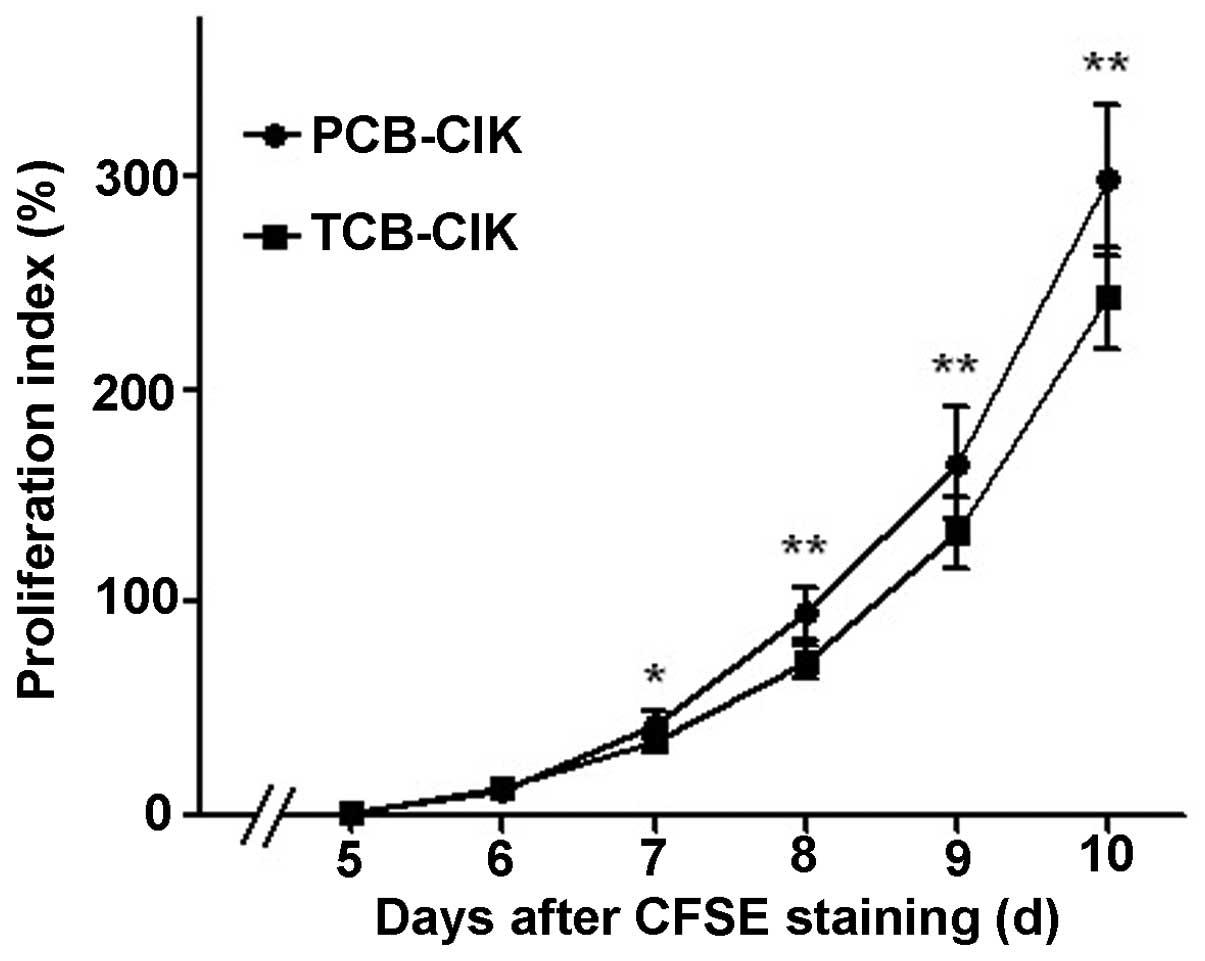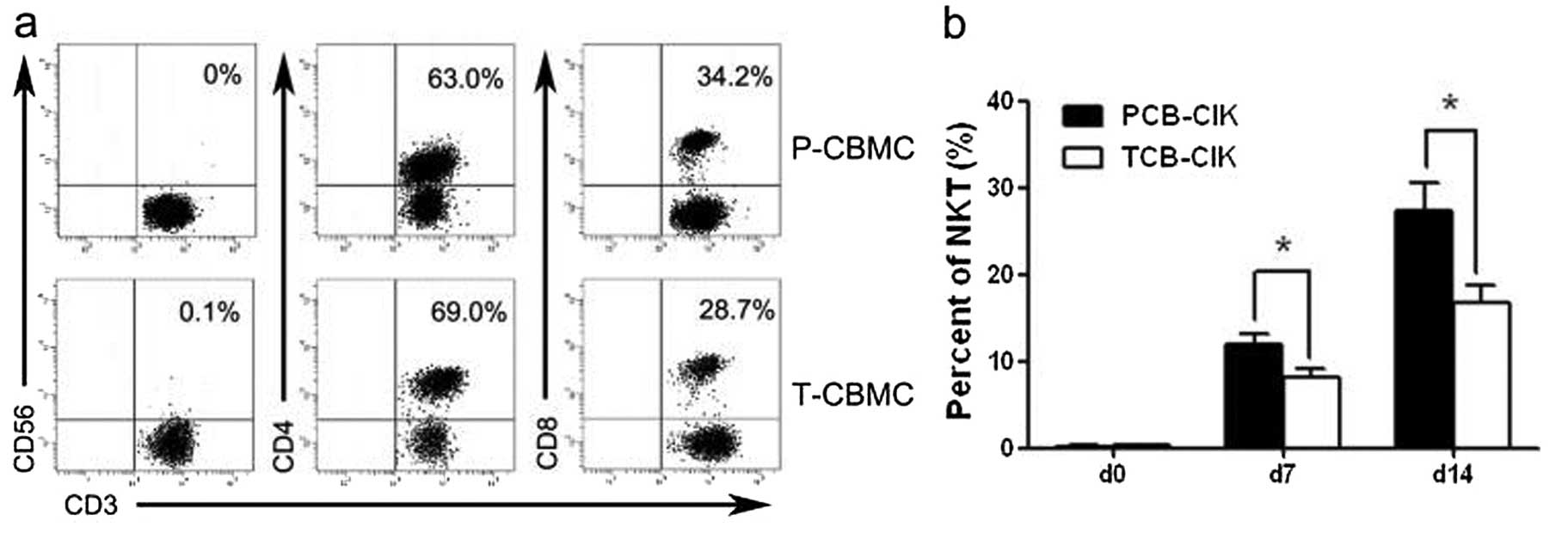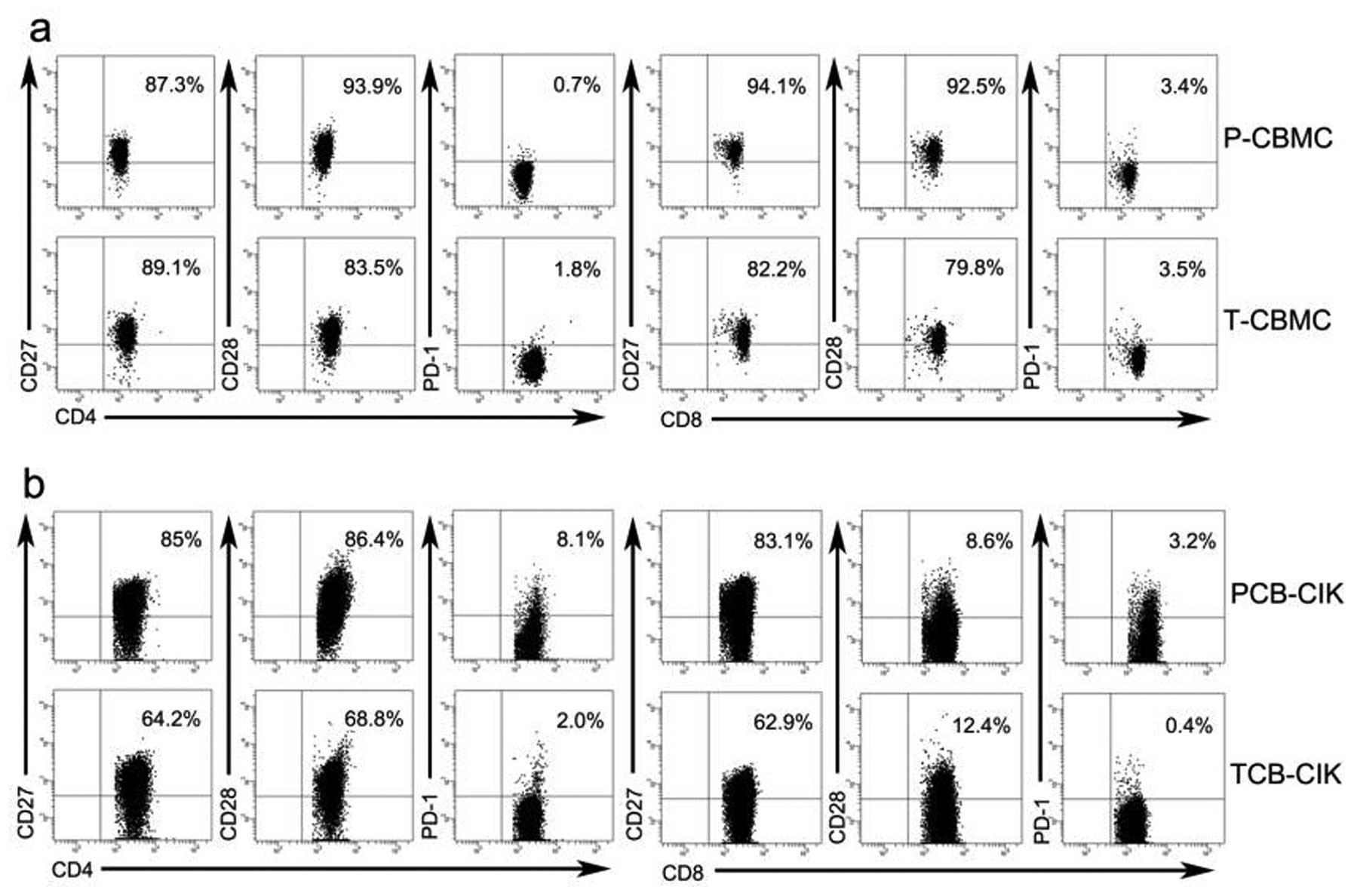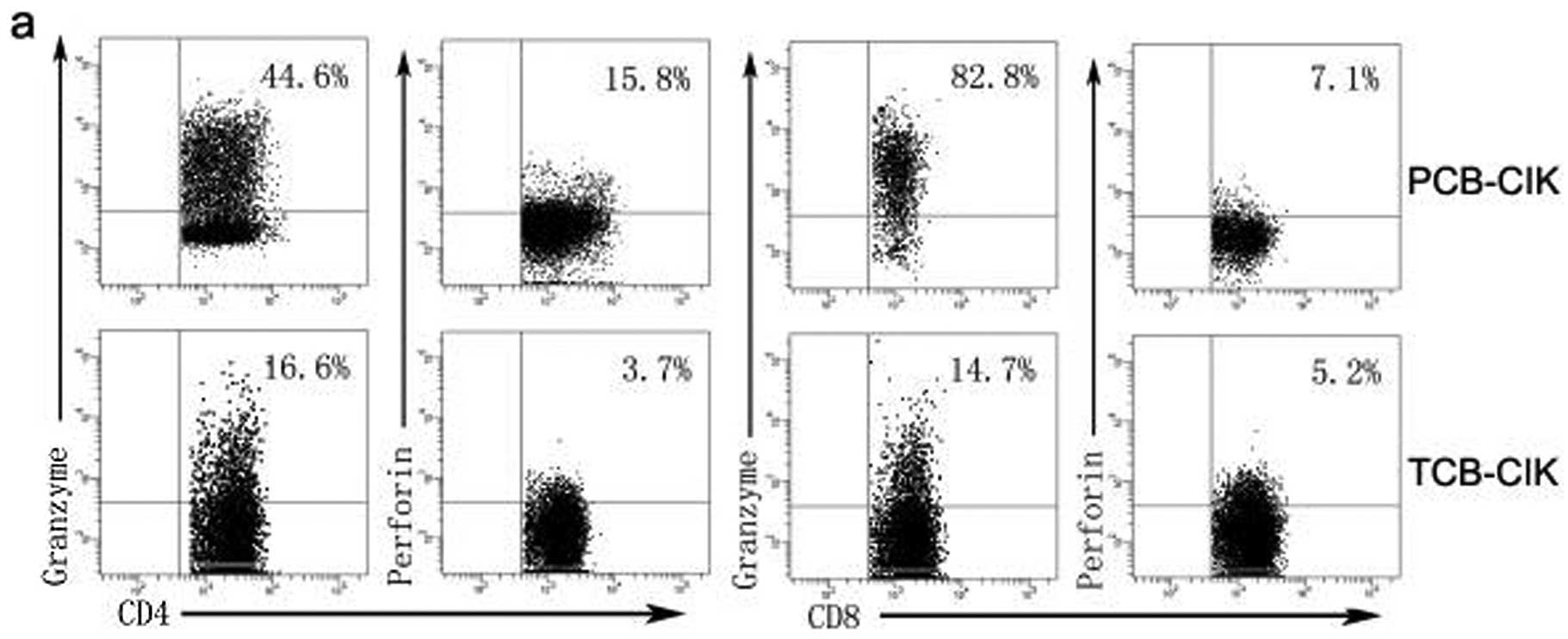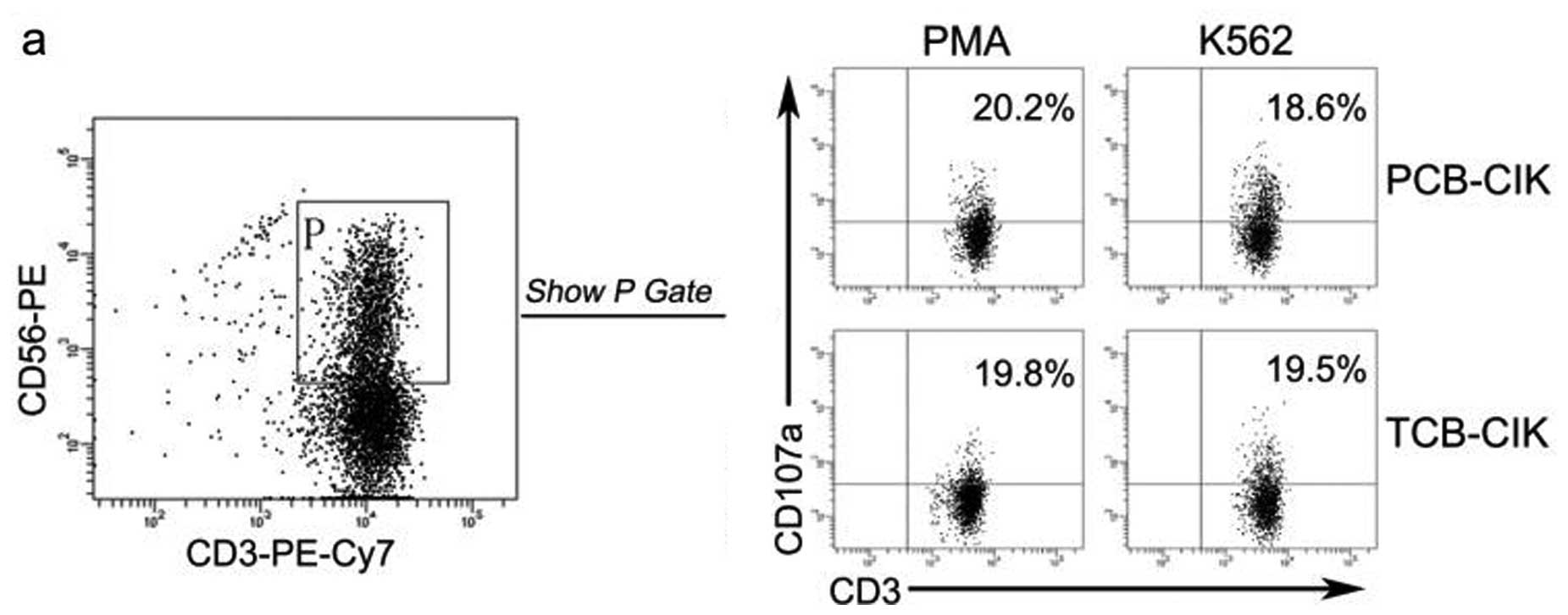|
1
|
Bear AS, Hanley PJ, Bosque DM, et al: Low
rate of infusional toxicity after expanded cord blood
transplantation. Cytotherapy. 16:1153–1157. 2014. View Article : Google Scholar : PubMed/NCBI
|
|
2
|
Humphries C: Adoptive cell therapy: honing
that killer instinct. Nature. 504:S13–S15. 2013. View Article : Google Scholar : PubMed/NCBI
|
|
3
|
Yee C: Adoptive T-cell therapy for cancer:
boutique therapy or treatment modality? Clin Cancer Res.
19:4550–4552. 2013. View Article : Google Scholar : PubMed/NCBI
|
|
4
|
Restifo NP, Dudley ME and Rosenberg SA:
Adoptive immunotherapy for cancer: harnessing the T cell response.
Nat Rev Immunol. 12:269–281. 2012. View
Article : Google Scholar : PubMed/NCBI
|
|
5
|
Schmidt-Wolf IG, Negrin RS, Kiem HP, et
al: Use of a SCID mouse/human lymphoma model to evaluate
cytokine-induced killer cells with potent antitumor cell activity.
J Exp Med. 174:139–149. 1991. View Article : Google Scholar : PubMed/NCBI
|
|
6
|
Pievani A, Borleri G, Pende D, et al:
Dual-functional capability of CD3+CD56+ CIK
cells, a T-cell subset that acquires NK function and retains
TCR-mediated specific cytotoxicity. Blood. 118:3301–3310.
2011.PubMed/NCBI
|
|
7
|
Liu L, Zhang W, Qi X, et al: Randomized
study of autologous cytokine-induced killer cell immunotherapy in
metastatic renal carcinoma. Clin Cancer Res. 18:1751–1759. 2012.
View Article : Google Scholar : PubMed/NCBI
|
|
8
|
Gammaitoni L, Giraudo L, Leuci V, et al:
Effective activity of cytokine-induced killer cells against
autologous metastatic melanoma including cells with stemness
features. Clin Cancer Res. 19:4347–4358. 2013. View Article : Google Scholar
|
|
9
|
Laport GG, Sheehan K, Baker J, et al:
Adoptive immunotherapy with cytokine-induced killer cells for
patients with relapsed hematologic malignancies after allogeneic
hematopoietic cell transplantation. Biol Blood Marrow Transplant.
17:1679–1687. 2011. View Article : Google Scholar
|
|
10
|
Ma YJ, He M, Han JA, et al: A clinical
study of HBsAg-activated dendritic cells and cytokine-induced
killer cells during the treatment for chronic hepatitis B. Scand J
Immunol. 78:387–393. 2013. View Article : Google Scholar : PubMed/NCBI
|
|
11
|
Mesiano G, Todorovic M, Gammaitoni L, et
al: Cytokine-induced killer (CIK) cells as feasible and effective
adoptive immunotherapy for the treatment of solid tumors. Expert
Opin Biol Ther. 12:673–684. 2012. View Article : Google Scholar : PubMed/NCBI
|
|
12
|
Helms MW, Prescher JA, Cao YA, et al:
IL-12 enhances efficacy and shortens enrichment time in
cytokine-induced killer cell immunotherapy. Cancer Immunol
Immunother. 59:1325–1334. 2010. View Article : Google Scholar : PubMed/NCBI
|
|
13
|
Chan JK, Hamilton CA, Cheung MK, et al:
Enhanced killing of primary ovarian cancer by retargeting
autologous cytokine-induced killer cells with bispecific
antibodies: a preclinical study. Clin Cancer Res. 12:1859–1867.
2006. View Article : Google Scholar
|
|
14
|
Frumento G, Zheng Y, Aubert G, et al: Cord
blood T cells retain early differentiation phenotype suitable for
immunotherapy after TCR gene transfer to confer EBV specificity. Am
J Transplant. 13:45–55. 2013. View Article : Google Scholar
|
|
15
|
Introna M, Pievani A, Borleri G, et al:
Feasibility and safety of adoptive immunotherapy with CIK cells
after cord blood transplantation. Biol Blood Marrow Transplant.
16:1603–1607. 2010. View Article : Google Scholar : PubMed/NCBI
|
|
16
|
Li J, Wang QH, Wu HM, et al: A survey of
neonatal births in maternity departments in urban China in 2005.
Zhongguo Dang Dai Er Ke Za Zhi. 14:7–10. 2012.(In Chinese).
|
|
17
|
Krzewski K, Gil-Krzewska A, Nguyen V, et
al: LAMP1/CD107a is required for efficient perforin delivery to
lytic granules and NK-cell cytotoxicity. Blood. 121:4672–4683.
2013. View Article : Google Scholar : PubMed/NCBI
|
|
18
|
Jiang J, Wu C and Lu B: Cytokine-induced
killer cells promote antitumor immunity. J Transl Med. 11:832013.
View Article : Google Scholar : PubMed/NCBI
|
|
19
|
Durrieu L, Gregoire-Gauthier J, Dieng MM,
et al: Human interferon-α increases the cytotoxic effect of
CD56+ cord blood-derived cytokine-induced killer cells
on human B-acute lymphoblastic leukemia cell lines. Cytotherapy.
14:1245–1257. 2012.
|
|
20
|
Li R, Wang C, Liu L, et al: Autologous
cytokine-induced killer cell immunotherapy in lung cancer: a phase
II clinical study. Cancer Immunol Immunother. 61:2125–2133. 2012.
View Article : Google Scholar : PubMed/NCBI
|
|
21
|
Yang L, Ren B, Li H, et al: Enhanced
antitumor effects of DC-activated CIKs to chemotherapy treatment in
a single cohort of advanced non-small-cell lung cancer patients.
Cancer Immunol Immunother. 62:65–73. 2013. View Article : Google Scholar : PubMed/NCBI
|
|
22
|
D’Alessio F, Mirabelli P, Gorrese M, et
al: Polychromatic flow cytometry analysis of CD34+
hematopoietic stem cells in cryopreserved early preterm human cord
blood samples. Cytometry A. 79:14–24. 2011.
|
|
23
|
Kornacker M, Moldenhauer G, Herbst M, et
al: Cytokine-induced killer cells against autologous CLL: direct
cytotoxic effects and induction of immune accessory molecules by
interferon-γ. Int J Cancer. 119:1377–1382. 2006.PubMed/NCBI
|
|
24
|
Zanon C, Stocchero M, Albiero E, et al:
Multivariate statistical data analysis as a tool to analyze ex vivo
expansion dynamics of cytokine-induced killer cells. Cytometry B
Clin Cytom. 86:257–262. 2014. View Article : Google Scholar : PubMed/NCBI
|
|
25
|
Niu Q, Wang W, Li Y, et al: Cord
blood-derived cytokine-induced killer cells biotherapy combined
with second-line chemotherapy in the treatment of advanced solid
malignancies. Int Immunopharmacol. 11:449–456. 2011. View Article : Google Scholar : PubMed/NCBI
|
|
26
|
van Lier RA, Borst J, Vroom TM, et al:
Tissue distribution and biochemical and functional properties of
Tp55 (CD27), a novel T cell differentiation antigen. J Immunol.
139:1589–1596. 1987.PubMed/NCBI
|
|
27
|
Taraban VY, Rowley TF, Kerr JP, et al:
CD27 costimulation contributes substantially to the expansion of
functional memory CD8+ T cells after peptide
immunization. Eur J Immunol. 43:3314–3323. 2013. View Article : Google Scholar : PubMed/NCBI
|
|
28
|
Pufnock JS, Cigal M, Rolczynski LS, et al:
Priming CD8+ T cells with dendritic cells matured using
TLR4 and TLR7/8 ligands together enhances generation of
CD8+ T cells retaining CD28. Blood. 117:6542–6551.
2011.
|
|
29
|
Prosser ME, Brown CE, Shami AF, et al:
Tumor PD-L1 co-stimulates primary human CD8+ cytotoxic T
cells modified to express a PD1:CD28 chimeric receptor. Mol
Immunol. 51:263–272. 2012. View Article : Google Scholar : PubMed/NCBI
|
|
30
|
Saga K, Tamai K, Yamazaki T, et al:
Systemic administration of a novel immune-stimulatory pseudovirion
suppresses lung metastatic melanoma by regionally enhancing IFN-γ
production. Clin Cancer Res. 19:668–679. 2013.PubMed/NCBI
|
|
31
|
Wang Y, Bo J, Dai HR, et al: CIK cells
from recurrent or refractory AML patients can be efficiently
expanded in vitro and used for reduction of leukemic blasts in
vivo. Exp Hematol. 41:241–252. 2013. View Article : Google Scholar : PubMed/NCBI
|
|
32
|
Wang YF, Kunda PE, Lin JW, et al:
Cytokine-induced killer cells co-cultured with complete tumor
antigen-loaded dendritic cells, have enhanced selective
cytotoxicity on carboplatin-resistant retinoblastoma cells. Oncol
Rep. 29:1841–1850. 2013.
|
|
33
|
Introna M, Franceschetti M, Ciocca A, et
al: Rapid and massive expansion of cord blood-derived
cytokine-induced killer cells: an innovative proposal for the
treatment of leukemia relapse after cord blood transplantation.
Bone Marrow Transplant. 38:621–627. 2006. View Article : Google Scholar
|
|
34
|
Kim TD, Lee SU, Yun S, et al: Human
microRNA-27a* targets Prf1 and GzmB expression to regulate NK-cell
cytotoxicity. Blood. 118:5476–5486. 2011. View Article : Google Scholar : PubMed/NCBI
|
|
35
|
Alter G, Malenfant JM and Altfeld M:
CD107a as a functional marker for the identification of natural
killer cell activity. J Immunol Methods. 294:15–22. 2004.
View Article : Google Scholar : PubMed/NCBI
|



